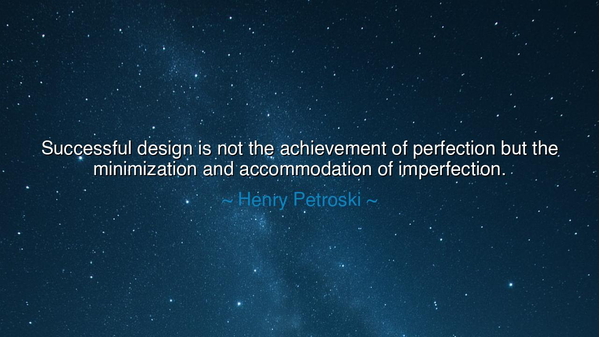
Successful design is not the achievement of perfection but the
Successful design is not the achievement of perfection but the minimization and accommodation of imperfection.






“Successful design is not the achievement of perfection but the minimization and accommodation of imperfection.” – Henry Petroski
Hear these words, O builders of worlds both great and small, from Henry Petroski, the philosopher of engineering and craftsmanship. His voice carries the humility of those who have studied deeply the works of human hands and the failures that gave them shape. When he declares that successful design is not the achievement of perfection but the minimization and accommodation of imperfection, he does not speak of surrender—but of wisdom. He reminds us that to design is to work within the boundaries of the possible, to honor both the limitations of material and the frailty of human endeavor.
For perfection is an illusion, a dream that gleams from afar but dissolves as one approaches. Nature itself, with all its majesty, holds no flawless symmetry—only harmony born of balance and adaptation. The mountains are eroded by wind; the stars decay in silence. Yet they remain magnificent. So too must the designer learn that greatness does not arise from the absence of flaw, but from the mastery of compromise, the graceful dance between what can be and what must be. Petroski, in his long study of bridges, machines, and failures, saw that every structure, no matter how well made, is a conversation with weakness—its beauty lies in how it endures, not in how it pretends to be invincible.
Consider the story of the Brooklyn Bridge, that monument of iron and faith. When it was first conceived, its builders dreamed of spanning the East River with perfect strength. Yet as the work began, tragedy struck: John Roebling, its visionary engineer, was gravely injured and died before its completion, leaving his son, Washington Roebling, to carry on. Soon after, Washington too was paralyzed by illness, and it was his wife, Emily, who brought his calculations to the workers and guided them to completion. The bridge that now stands is not perfect—it flexes, it creaks, it requires constant maintenance—but it endures because it was designed to accommodate imperfection. Its success was not in erasing human frailty, but in embracing it—building with strength where weakness was known to exist, allowing flexibility where rigidity would have caused ruin.
This, then, is Petroski’s truth: good design accepts imperfection as inevitable and seeks to live wisely with it. The poor designer chases perfection endlessly, only to be undone by it. The wise one studies failure, learns from it, and makes allowance for it. Every bridge has a limit, every airplane a tolerance, every tool a breaking point. Success is not the elimination of these limits, but the understanding of them—the weaving of safety and grace into the fabric of what is possible.
Even beyond engineering, this wisdom extends to life itself. For every life is a design, every decision a construction, every relationship a bridge between souls. And just as no structure stands without stress, no human being lives without flaw. To demand perfection from oneself or others is to invite collapse. But to design one’s life with humility—to allow for error, forgiveness, and growth—is to build something enduring. As Petroski teaches, success lies not in purity but in resilience.
Think also of Japanese craftsmanship, where the philosophy of wabi-sabi honors the beauty of imperfection. A cracked bowl repaired with gold is not discarded—it becomes more precious, its flaws illuminated rather than hidden. So too should we view our designs and our lives: not as failures when imperfect, but as living works that become more meaningful with every repair, every adaptation, every learned improvement. This is the art of endurance, the mark of true mastery.
Let this teaching, then, be your compass: strive not for perfection, but for understanding. In your work, anticipate failure; in your relationships, allow grace; in your dreams, build flexibility. For the strongest structures are not those that resist all pressure, but those that bend without breaking. The perfect design is not flawless—it is faithful, enduring, and wise.
And thus, as Henry Petroski reminds us, the path to mastery lies not in erasing imperfection, but in harmonizing with it. To design, to build, to live—these are all acts of balance between fragility and strength. The designer’s greatest triumph is not that nothing fails, but that when failure comes, the whole still stands. So design your bridges and your days alike with this truth in mind: perfection is a mirage, but wisdom endures forever.






AAdministratorAdministrator
Welcome, honored guests. Please leave a comment, we will respond soon